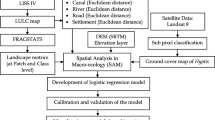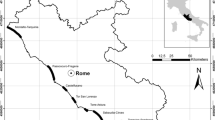Abstract
Predicting the vulnerability of landscapes to both the initial colonisation and the subsequent spread of invasive species remains a major challenge. The aim of this study was to assess the relative importance of sub-patch level factors and landscape factors for the invasion of the megaforb Heracleum mantegazzianum. In particular, we tested which factors affect the presence in suitable habitat patches and the cover-percentage within invaded patches. For this purpose, we used standard (logistic) regression modelling techniques. The regression analyses were based on inventories of suitable habitat patches in 20 study areas (each 1 km2) in cultural landscapes of Germany. The cover percentage in invaded patches was independent from landscape factors, except for patch shape, and even unsatisfactorily explained by sub-patch level factors included in the analysis (R 2 = 0.19). In contrast, presence of H. mantegazzianum was affected by both local and landscape factors. Woody habitat structure decreased the occurrence probability, whereas vicinity to transport corridors (rivers, roads), high habitat connectivity, patch size and perimeter-area ratio of habitat patches had positive effects. The significance of corridors and habitat connectivity shows that dispersal of H. mantegazzianum through the landscape matrix is limited. We conclude that cultural landscapes of Germany function as patch-corridor-matrix mosaics for the spread of H. mantegazzianum. Our results highlight the importance of landscape structure and habitat configuration for invasive spread. Furthermore, this study shows that both local and landscape factors should be incorporated into spatially explicit models to predict spatiotemporal dynamics and equilibrium stages of plant invasions.



Similar content being viewed by others
References
Bartuszevige AM, Gorchov DL, Raab L (2006) The relative importance of landscape and community features in the invasion of an exotic shrub in a fragmented landscape. Ecography 29:213–222
Caffrey JM (1999) Phenology and long-term control of Heracleum mantegazzianum. Hydrobiologia 415:223–228
Collingham YC, Huntley B (2000) Impacts of habitat fragmentation and patch size upon migration rates. Ecol Appl 10:131–144
de Blois S, Domon G, Bouchard A (2002) Landscape issues in plant ecology. Ecography 25:244–256
Deckers B, Verheyen K, Hermy M, Muys B (2005) Effects of landscape structure on the invasive spread of black cherry Prunus serotina in an agricultural landscape in Flanders, Belgium. Ecography 28:99–109
Deil U, Ludemann T (2003) Vegetation analysis at the landscape level—an introduction. Phytocoenologia 33:561–564
Dupré C, Ehrlén J (2002) Habitat configuration, species traits and plant distributions. J Ecol 90:796–805
Ehrlén J, Eriksson O (2003) Large-scale spatial dynamics of plants: a response to Freckleton and Watkinson. J Ecol 91:316–320
Eriksson O, Ehrlén J (2001) Landscape fragmentation and the viability of plant populations. In: Silvertown J, Antonovics J (eds) Integrating ecology and evolutions in a spatial context. Blackwell Science, Oxford, pp 157–175
Eriksson O, Cousins SAO, Bruun HH (2002) Land-use history and fragmentation of traditionally managed grasslands in Scandinavia. J Veg Sci 13:743–748
Forman RTT (1995) Land mosaics: the ecology of landscapes and regions. Cambridge University Press, Cambridge
Freckleton RP, Watkinson AR (2002) Large-scale spatial dynamics of plants: metapopulations, regional ensembles and patchy populations. J Ecol 90:419–434
Gelbard JL, Belnap J (2003) Roads as conduits for exotic plant invasions in a semiarid landscape. Conserv Biol 17:420–432
Godefroid S, Koedam N (2004) The impact of forest paths upon adjacent vegetation: effects of the path surfacing material on the species composition and soil compaction. Biol Conserv 119:405–419
Hansen MJ, Clevenger AP (2005) The influence of disturbance and habitat on the presence of non-native plant species along transport corridors. Biol Conserv 125:249–259
Horskins K, Mather PB, Wilson JC (2006) Corridors and connectivity: when use and function do not equate. Landsc Ecol 21:641–655
Hüls J (2005) Untersuchungen zur Populationsbiologie an Heracleum mantegazzianum Somm. & Lev. in Subpopulationen unterschiedlicher Individuendichte. Dissertation, University of Giessen, Giessen, Germany
Jelinski DE, Wu J (1996) The modifiable areal unit problem and implications for landscape ecology. Landsc Ecol 11:129–140
King AW, With KA (2002) Dispersal success on spatially structured landscapes: when do spatial pattern and dispersal behavior really matter? Ecol Model 147:23–39
Kirchner F, Ferdy J-B, Andalo C, Colas B, Moret J (2003) Role of corridors in plant dispersal: an example with the endangered Ranunculus nodiflorus. Conserv Biol 17:401–410
Kolb A, Diekmann M (2005) Effects of life-history traits on responses of plant species to forest fragmentation. Conserv Biol 19:929–938
Legendre P, Legendre L (1998) Numerical ecology. Elsevier, Amsterdam
Lortie CJ, Brooker RW, Choler P, Kikvidze Z, Michalet R, Pugnaire FI, Callaway RM (2004) Rethinking plant community theory. Oikos 107:433–438
McGarigal K, Marks BJ (1995) FRAGSTATS: spatial pattern analysis program for quantifying landscape structure. USDA For Serv Gen Tech Rep PNW-351, Portland
Müllerová J, Pyšek P, Jarošík V, Pergl J (2005) Aerial photographs as a tool for assessing the regional dynamics of the invasive plant species Heracleum mantegazzianum. J Appl Ecol 42:1042–1053
Murphy HT, Lovett-Doust J (2004) Context and connectivity in plant metapopulations and landscape mosaics: does the matrix matter? Oikos 105:3–14
Otte A, Franke R (1998) The ecology of the Caucasian herbaceous perennial Heracleum mantegazzianum Somm. et Lev. (Giant Hogweed) in cultural ecosystems of Central Europe. Phytocoenologia 28:205–232
Otte A, Eckstein RL, Thiele J (2007) Heracleum mantegazzianum in its primary distribution range of the Western Greater Caucasus. In: Pyšek P, Cock MJW, Nentwig W, Ravn HP (eds) Ecology and management of Giant Hogweed (Heracleum mantegazzianum). CAB International, Wallingford
Parendes LA, Jones JA (2000) Role of light availability and dispersal in exotic plant invasion along roads and streams in the H. J. Andrews Experimental Forest, Oregon. Conserv Biol 14:64–75
Pauchard A, Alaback PB (2004) Influence of elevation, land use, and landscape context on patterns of alien plant invasions along roadsides in protected areas of south-central Chile. Conserv Biol 18:238–248
Pyšek P (1991) Heracleum mantegazzianum in the Czech Republik: dynamics of spreading from the historical perspective. Folia Geobot 26:439–454
Pyšek P, Pyšek A (1995) Invasion by Heracleum mantegazzianum in different habitats in the Czech Republic. J Veg Sci 6:711–718
Rentch JS, Fortney RH, Stephenson SL, Adams HS, Grafton WN, Anderson JT (2005) Vegetation-site relationships of roadside plant communities in West Virginia, USA. J Appl Ecol 42:129–138
Rew LJ, Maxwell BD, Aspinall R (2005) Predicting the occurrence of nonindigenous species using environmental and remotely sensed data. Weed Sci 53:236–241
Schemske DW, Husband BC, Ruckelshaus MH, Goodwillie C, Parker IM, Bishop JG (1994) Evaluating approaches to the conservation of rare and endangered plants. Ecology 75:584–606
Stephenson CM, MacKenzie ML, Edwards C, Travis JMJ (2006) Modelling establishment probabilities of an exotic plant, Rhododendron ponticum, invading a heterogeneous, woodland landscape using logistic regression with spatial autocorrelation. Ecol Model 193:747–758
Tewksbury JJ, Levey DJ, Haddad NM, Sargent S, Orrock JL, Weldon A, Danielson BJ, Brinkerhoff J, Damschen EI, Townsend P (2002) Corridors affect plants, animals, and their interactions in fragmented landscapes. Proc Natl Acad Sci USA 99:12923–12926
Thiele J, Otte A (2006) Analysis of habitats and communities invaded by Heracleum mantegazzianum Somm. et Lev. (Giant Hogweed) in Germany. Phytocoenologia 36:281–320
Thiele J, Otte A (2008) Invasion patterns of Heracleum mantegazzianum in Germany on the regional and landscape scale. J Nat Conservat 16(1)
Tiley GED, Dodd FS, Wade PM (1996) Heracleum mantegazzianum SOMMIER & LEVIER. J Ecol 84:297–319
Wiens JA (2002) Central concepts and issues of landscape ecology. In: Gutzwiller KJ (ed) Applying landscape ecology in biological conservation. Springer, Berlin, pp 3–21
With KA (2004) Assessing the risk of invasive spread in fragmented landscapes. Risk Anal 24:803–815
Acknowledgements
This study was carried out as part of the EU-Project ‘Giant Alien’ (Project-No.: EVK2-2001-CT-00128). We thank Lutz Eckstein, Dietmar Simmering, and three anonymous reviewers for their helpful comments on the manuscript.
Author information
Authors and Affiliations
Corresponding author
Rights and permissions
About this article
Cite this article
Thiele, J., Schuckert, U. & Otte, A. Cultural landscapes of Germany are patch-corridor-matrix mosaics for an invasive megaforb. Landscape Ecol 23, 453–465 (2008). https://doi.org/10.1007/s10980-008-9202-2
Received:
Accepted:
Published:
Issue Date:
DOI: https://doi.org/10.1007/s10980-008-9202-2




